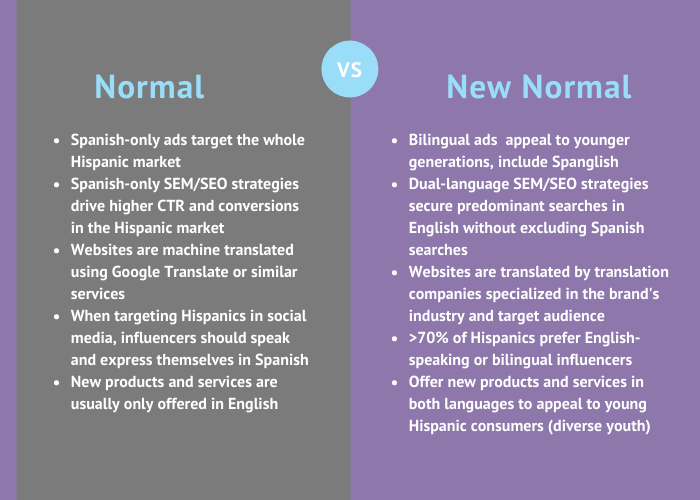How Language Code-Switching Changed Hispanic Marketing

Spanglish, a hybrid of English and Spanish, is widely spoken across the U.S. and prominent in bilingual communities. This term can be traced back to the Treaty of Guadalupe Hidalgo in 1848 and the Gadsden Purchase of 1853. Mexico’s northern lands claimed by the U.S. eventually became today’s Arizona, California, New Mexico, and others.
The native Spanish speakers, Mexicans, who lived in these lands automatically became U.S. citizens, and that’s where the clash between the two languages and cultures began.
Over time, this intermingling gave way to various sociolinguistic trends closely tied to acculturation processes: Spanish-dominant, Anglo-dominant, and bilingual.
Spanglish then became a “middle ground communication strategy”[1] that didn’t closely follow grammar, spelling, or syntax rules in English or Spanish.
However, the bilingual category became a topic of interest in sociolinguistic studies of the 19th century, and different terms started to emerge. Enter code-switching.
Language code-switching is “the use of two or more languages or varieties of the same language in the same utterance or conversation.”[2] Using Spanglish allows Latinos to tap into the American ethos without surrendering their Hispanic identity.
Given its prevalence in the Hispanic community, marketers are taking a closer look at code-switching and its impact on messaging and consumer experience.
Language Code-Switching Among Generational Groups
Last year, ThinkNow and 9thWonder explored Hispanics’ digital purchasing patterns in a report mapping their online path to purchase. In addition to the digital data points, the findings also revealed that code-switching was “a way of life.”
Of the study’s 500 self-identified Hispanic consumers (ages 18-64), 27% lived in multigenerational households.
Multigenerational households are defined as households consisting of three or more generations of parents and their families.
Younger generations (third-generation onwards) were more likely to be bilingual and technologically savvy, having had more time to assimilate their parents (second generation) and grandparents (first generation).
Pew Research concluded similar findings in a 2017 study on Hispanic identity that surveyed 1,500 self-identified Hispanics. They found that half (51%) of the self-identified, second-generation Latinos labeled themselves bilingual.
Eighty-eight percent of those surveyed, including 64% from the group of self-identified non-Hispanics with Hispanic ancestry, said it was important that future generations of Hispanics in the U.S. speak Spanish.
Thus, language code-switching starts in the second generation, where both educational and professional opportunities are increasingly attainable, and accelerates within the third-generation, strengthening cultural assimilation tendencies.
Acculturation’s Role in Language Code-Switching
Let’s look at this through a marketing lens. Last year, we wrote about the importance of segmenting Hispanic audiences in transition subgroups. We concluded that marketers might choose to focus on Spanish-only campaigns for the Hispanic-dominant consumers and English-only campaigns for the English-dominant.
However, we also mentioned that younger generations were driving a “third-force” that ni es de aquà ni de allá (neither from the U.S. nor from the country of origin) due to acculturation.
This third force is reliably bilingual , they switch languages and cultural codes with finesse.
The new challenge marketers face with this highly acculturated group is that it acts as a gatekeeper to older generations and determines whether the content (e.g., a social media ad) is genuine, relevant, and useful.
Concerning relevancy and usefulness, Alvarez et al. (2014)[3] explain:
“Effective marketing to the U.S. Hispanic population requires more than simply using Spanish-language media or in-store communications that emphasize Hispanic values. Such a marketing campaign likely appeals to all Hispanics, but the communication will reach only about one-half of the Hispanic market… Mail offerings, brochures, and even websites should offer to the bilingual consumer the opportunity to choose their language of preference.”
Years later, H Code’s 2020 Hispanic Digital Fact Pack reconfirmed the need for bilingual Hispanic consumers to feel that brands portray their “bilingual experience.”
Code-Switching Shifts Trend in Hispanic Marketing
Bilingual Hispanics can toggle between Spanish and English, thus changing the dynamics of Hispanic marketing. We have identified five Hispanic marketing trends that have shifted in response to language code-switching, generational groups, and acculturation levels.

- Spanish-only vs. Bilingual ads: Early on, Spanish-only ads targeted the general Hispanic market. Fortunately, marketers are starting to realize that Hispanics are not a monolithic group. Language and acculturation levels are key differentiators. Bilingual ads are more appealing to younger generations.
- Spanish-only vs. Bilingual SEM/SEO strategies: Current convention says Spanish-only SEM/SEO strategies drive higher click-through rates and conversions in the Hispanic market. Studies show that dual-language SEM-SEO strategies manage to secure predominant English searches (52%) without Spanish searches (23-25%).[4]
- App Translations vs. Translation Experts: It’s not uncommon for websites to be more machine-translated using Google Translate or similar services. But more effective websites are translated by translation companies specialized in the brand’s industry and target audience.
- Spanish-dominant vs. Bilingual Influencers: When targeting Hispanics in social media, many believe that influencers should speak and express themselves in Spanish. Research shows, however, that more than 70% of Hispanics prefer English-speaking or bilingual influencers (second- or third-generation Hispanics)[5]
- English-only products/services vs. Bilingual offerings: New products and services are typically offered in English. But according to Culture Marketing Council’s 2020 Hispanic Marketing Guide, offering new products and services in both languages is essential to appealing to young Hispanic consumers and diverse youth in general. These early adopters are influencers at home, thus likely impacting purchasing decisions.
One Size Doesn’t Fit All
Language code-switching is more than knowing which phrases to script into the messaging for a Hispanic marketing campaign. Language is an integral part of Hispanic culture and reflects a broad spectrum of communities. Demographic factors like location, immigration status, education level, household income, and psychographic factors like lifestyle, beliefs, and values must also be considered if marketers are to create campaigns that resonate with this consumer and incent them to take the desired actions.
For instance, regardless of how much a new popular smartphone ad campaign might appeal to different demographics on a cultural level, it still might be irrelevant if the price range is outside their purchasing power. Likewise, low-income multigenerational households will only be drawn to products and services that address their basic needs.
For these reasons and more, cultural research makes a difference, and resulting insights validate multicultural marketing initiatives.
—
Content written in partnership with The Translation Team
[1] Stavans, Ilan (2003), Spanglish: The Making of a New American Language, HarperCollins Publishers, Inc.: NY.
[2] Derrick, Roshawnda A. (2015). Code-Switching, Code-Mixing and Radical Bilingualism In U.S. Latino Texts. Wayne State University Dissertations. 1309.
[3] Alvarez, C. M. O., Dickson, P. R., & Hunter, G. K. (2014). The four faces of the Hispanic consumer: An acculturation-based segmentation. Journal of Business Research, 67(2), 108–115. https://doi.org/10.1016/j.jbusres.2012.11.010
[4] ThinkNow, 9th Wonder (2020). 2020 Guide to Hispanic Digital Purchase Behavior. Accessed on March 6th, 2021. https://www.9thwonder.com/guide-to-hispanic-digital-purchasing-behavior
[5] Morse, P. (2020). 2020 Hispanic Digital Fact Pack (p. 44). H Code. https://hcodemedia.com/press/hispanic-digital-fact-pack/





